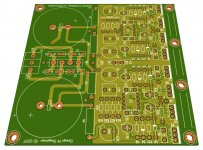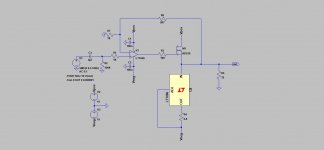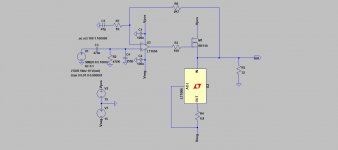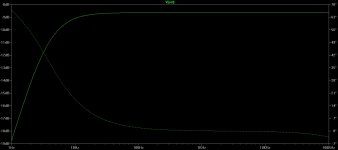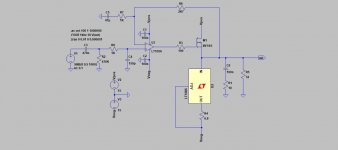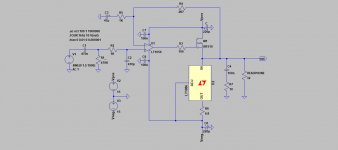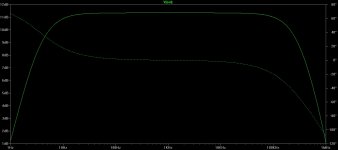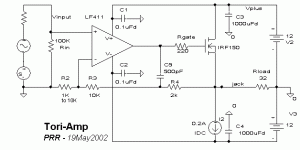I have been working on a mosfet buffered class A headphone amplifier.
Onboard power supply
Bridge rectifier and C-R-C smoothing
Separate voltage regulators for both channels (lm317/lm337)
Single opamp for voltage amplification
Class A Mosfet output buffer
LM317 Constant Current Source for bias
Heatsink can be mounted on the ridge of the PCB, making it one unit.
Done a test with LF356 opamp and IRF510 mosfet, works great.
Now working on the PCB layout, should fit on a 10x10cm board.
Onboard power supply
Bridge rectifier and C-R-C smoothing
Separate voltage regulators for both channels (lm317/lm337)
Single opamp for voltage amplification
Class A Mosfet output buffer
LM317 Constant Current Source for bias
Heatsink can be mounted on the ridge of the PCB, making it one unit.
Done a test with LF356 opamp and IRF510 mosfet, works great.
Now working on the PCB layout, should fit on a 10x10cm board.
Attachments
Last edited:
Looks good 🙂
A couple of thoughts... a FET input opamp doesn't need R1, also you can increase R2 and decrease C3 and so use a small film cap. There is no noise penalty as the resistor is shunted by the impedance of the driving source component. 470k and 0.47uF are standard sort of values and would give an LF response way below anything useful for headphones.
An input RF filter might be a good idea.
Although there should be no offset issues with a FET opamp, you should consider returning the internal gain to unity at DC (which means a cap in the feedback return).
A couple of thoughts... a FET input opamp doesn't need R1, also you can increase R2 and decrease C3 and so use a small film cap. There is no noise penalty as the resistor is shunted by the impedance of the driving source component. 470k and 0.47uF are standard sort of values and would give an LF response way below anything useful for headphones.
An input RF filter might be a good idea.
Although there should be no offset issues with a FET opamp, you should consider returning the internal gain to unity at DC (which means a cap in the feedback return).
After observing that current source bias resistor R4 will dissipate 230 mW, I would be tempted to stuff and solder a resistor rated for 2 watts continuous dissipation, such as (this) 2W resistor whose dimensions are only 3.9mm x 10mm.
I think I would also include a Zobel network on the output, which loads the amplifier and prevents oscillation, when no headphones are plugged in.
Finally, I personally prefer a 2C+1R snubber across the transformer secondary, instead of 4 capacitors across all 4 diodes in the bridge rectifier (as shown on the PCB layout). I myself prefer to control the damping of the transformer secondary circuit, and indeed I deliberately choose to overdamp the secondary (zeta >= 1.0) to guarantee the complete absence of ringing. There is a .pdf document called Quasimodo here on the DIYA website, which discusses my snubber preferences at length. But, I hasten to point out, these are my preferences. Other design engineers have their own preferred approaches, of course.
I think I would also include a Zobel network on the output, which loads the amplifier and prevents oscillation, when no headphones are plugged in.
Finally, I personally prefer a 2C+1R snubber across the transformer secondary, instead of 4 capacitors across all 4 diodes in the bridge rectifier (as shown on the PCB layout). I myself prefer to control the damping of the transformer secondary circuit, and indeed I deliberately choose to overdamp the secondary (zeta >= 1.0) to guarantee the complete absence of ringing. There is a .pdf document called Quasimodo here on the DIYA website, which discusses my snubber preferences at length. But, I hasten to point out, these are my preferences. Other design engineers have their own preferred approaches, of course.
Looks good 🙂
A couple of thoughts... a FET input opamp doesn't need R1, also you can increase R2 and decrease C3 and so use a small film cap. There is no noise penalty as the resistor is shunted by the impedance of the driving source component. 470k and 0.47uF are standard sort of values and would give an LF response way below anything useful for headphones.
An input RF filter might be a good idea.
Although there should be no offset issues with a FET opamp, you should consider returning the internal gain to unity at DC (which means a cap in the feedback return).
Thanks for the input 🙂
I have made some changes, however not sure about the RF input filtering. Is this what you mean?
Attachments
You need a RF filter at the input.
R1=1kOhm
C=470pF FKP/MKP
Ok, so it is a series R / parallel C lowpass filter.
Would this be a good capacitor for this purpose?
https://www.eoo-bv.nl/stabiele-hq-366pf920pf/15803-hq-470pf-630v-2.html
Pitch for the CCS resistor is bigger then the rest (12.5mm) so I should be able to fit this resistor MF 6,8 Ω 2W 5% MO
I have added a zobel to the output, is 100n / 10Ohm ok?
I have added a zobel to the output, is 100n / 10Ohm ok?
After observing that current source bias resistor R4 will dissipate 230 mW, I would be tempted to stuff and solder a resistor rated for 2 watts continuous dissipation, such as (this) 2W resistor whose dimensions are only 3.9mm x 10mm.
I think I would also include a Zobel network on the output, which loads the amplifier and prevents oscillation, when no headphones are plugged in.
Finally, I personally prefer a 2C+1R snubber across the transformer secondary, instead of 4 capacitors across all 4 diodes in the bridge rectifier (as shown on the PCB layout). I myself prefer to control the damping of the transformer secondary circuit, and indeed I deliberately choose to overdamp the secondary (zeta >= 1.0) to guarantee the complete absence of ringing. There is a .pdf document called Quasimodo here on the DIYA website, which discusses my snubber preferences at length. But, I hasten to point out, these are my preferences. Other design engineers have their own preferred approaches, of course.
Attachments
You need a RF filter at the input.
R1=1kOhm
C=470pF FKP/MKP
Why is a MKP capacitor necessary for a RF filter?
The lt1086 and lm317 are positive voltage regulators. Will it work when the out pin is connected to negative supply ?
The RF filter looks OK. 470pF is suitable to use with a 1k. Any decent small film cap is fine, but not a ceramic disc type.
I'd put 470 kΩ to ground on the "outside" of the input coupling cap to prevent the cap from charging when the input is disconnected.
Tom
Tom
Schematic
First, change connection to inverting.
Second, read this thoroughly:
http://www.ti.com/lit/an/slyt174/slyt174.pdf
Use circuit B with something like AD8067, LT1222, LM7171, THS4021.
Third, drop linear regs, use passive CRC with 7-10 Ohms inline. Decouple opamp locally closer than 5 mm, higher than 10 nF NP0.
Fourth, drop MOSFET, use medium power BJT this will shift opamp’s output stage slightly with A-class guarantee and decrease load capacitance.
Fifth, do not use toroid trafo for supply, only sectioned El.
Eight, put little common mode choke at the input.
Seventh, put common mode choke at the output.
I'd put 470 kΩ to ground on the "outside" of the input coupling cap to prevent the cap from charging when the input is disconnected.
Tom
Hi Tom,
Is this resistor still needed whene there is a potmeter on the input?
The idea was to make a mosfet output stage and use fet input opamp. I will stick with that idea for the moment.
Attachments
Last edited:
Is this resistor still needed whene there is a potmeter on the input?
If you have a volume pot soldered to the input of the amp board, the volume pot will drain the cap.
Tom
Third, drop linear regs, use passive CRC with 7-10 Ohms inline. Decouple opamp locally closer than 5 mm, higher than 10 nF NP0.
That will greatly increase the supply impedance compared to the regulated supply. It will also result in worse filtering, in particular when the parasitics of the supply caps are factored in.
As for inverting vs non-inverting: I'm assuming you're concerned about common-mode distortion. That's not really a thing anymore with modern opamps. I'm sure you can find one opamp out there somewhere that shows common-mode distortion, but amps like the LME49710, OPA1611, etc. perform better non-inverting than inverting, at least for buffer applications, due to the 6 dB higher loop gain of the non-inverting configuration.
Tom
Is Tori still around??
I don't know why you would want +/-15V and 200mA for any headphone. Well, maybe this week, we are in for a cold spell.
When I looked at this, a long time ago, I could not avoid a ~~10MHz instability without the added C5-R4 network to decouple the NFB above 150KHz.
I don't know why you would want +/-15V and 200mA for any headphone. Well, maybe this week, we are in for a cold spell.
When I looked at this, a long time ago, I could not avoid a ~~10MHz instability without the added C5-R4 network to decouple the NFB above 150KHz.
Attachments
- Status
- Not open for further replies.
- Home
- Amplifiers
- Headphone Systems
- Mosfet class A headphone amplifier
